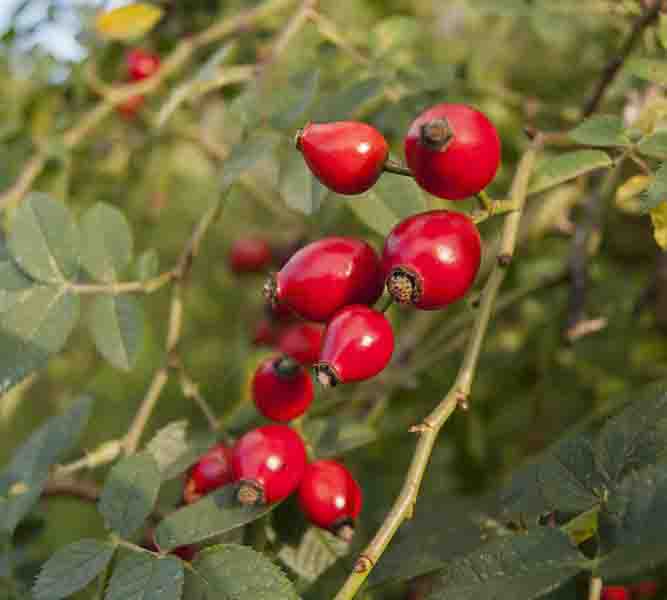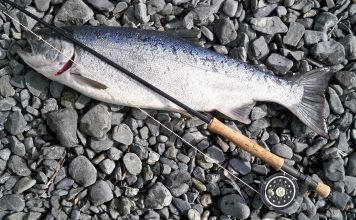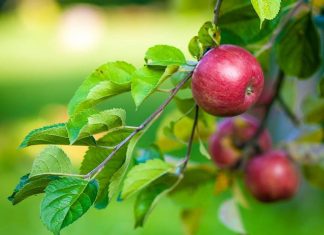| Issue #95 • September/October, 2005 |
Vitamin C-rich rose hips can be found in dried form in most health food stores, but why not gather your own? You’ll save money and you’ll know where they came from and the conditions in which they grew. Furthermore, you’ll be adding to your own self-sufficiency by locating and gathering a nutrient-dense food source to nourish yourself and your family.
Growing along the main irrigation canal in the small farming community where I live are hedgerows of wild roses. In spring they produce lovely pink blossoms. As the petals fade, a green hip, or hypanthium, begins to swell at each blossom’s base. From mid-September into October when they are fully red and ripe, and before frost tinges their foliage with autumn color making the hips harder to see, I gather bagfuls for making soup, wine, syrup, jelly, and tea.
|
If you live, as I do, in a temperature zone that’s too cold to grow citrus fruit, rose hips are an excellent alternative food source of Vitamin C. All roses are edible, but we are most familiar with the rose’s tasty cousins—fruits such as plums, apples, blackberries, and raspberries—all of which have small, rose-like white or pink flowers before setting fruit. A rose hip is merely the fruit of the rose plant.
Unlike their popular fruiting cousins, rose hips don’t have much flesh beneath their skins. Instead, they are filled with tiny seeds covered with silky hairs. The skin of the hip, often tasting like an apple, is where most of the food value and nutrition lies.
Nutritional powerhouses
Known mostly for beauty in the garden and as a floral declaration of love, roses don’t usually come to mind when we think of either food or nutrition. Yet, all parts of the rose, and especially the hips, are storehouses of Vitamin C and other important nutrients.
Compare the nutritional content of oranges to rose hips and you will find that rose hips contain 25 percent more iron, 20 to 40 percent more Vitamin C (depending upon variety), 25 times the Vitamin A, and 28 percent more calcium.
|
In addition, rose hips are a rich source of bioflavanoids, pectin, Vitamin E, selenium, manganese, and the B-complex vitamins. Rose hips also contain trace amounts of magnesium, potassium, sulfur and silicon.
Finding and gathering rose hips
Wild roses grow throughout the world. There are literally thousands of varieties worldwide and most have been part of the human diet. In fact, it is difficult to find an area of the world or a temperature zone—barring parts of the Antarctic and the Sahara Desert—where wild roses don’t grow.
We can also look to our own gardens. The domesticated roses we find there are rich in nutrients. Look for Rosa rugosa that develops many large, bright red hips that look and taste like small apples. Rugosa roses are found in most nurseries and plant catalogs. Rosa gallica, a native of the Middle East no longer found in the wild but available from nurseries and plant catalogs, is a favored old garden rose. It will grace your garden with beauty and scent and your table with nutritious foods and beverages. Even the well-loved “hybrid tea” roses produce edible hips, although not as prolifically as their wild and semi-domesticated garden cousins.
|
Many enthusiastic gardeners never see the development of colorful hips because as soon as blossoms fade they are snipped off to tidy up the garden. Blossoms must be left on the plant to naturally fade and fall for hips to develop.
The most abundant source of Vitamin C-rich rose hips is from wild hedgerows and thickets. Here hips can be gathered in ample quantities for cooking and storing. You’d have to grow a vast number of garden-variety roses to get a sufficient quantity of hips for use all year long. As most roses have thorns, gloves are helpful although not essential when gathering hips.
Rose hips as food
Once you locate your rose hip source there still remains the question of turning them into something we deem not only edible, but tasty too. Rose hips can be made into a variety of appetizing, healthy dishes. Turned into jelly, syrup, and wine, they make delightful gifts.
Rose hips may be used fresh or dried. To dry them, discard any with discoloration then rinse in cold water, pat dry, and spread on a wax paper-lined cookie sheet. It takes a couple of weeks for them to dry. They will be darker in color, hard, and semi-wrinkly. Rub off any stems or remaining blossom ends. Pour them into jars for storage in a dark pantry or cupboard.
One of my favorite ways to use rose hips is to brew them into tea. For tea they may be used fresh or dried. For fresh brewing, steep a tablespoon or two of clean hips in a cup of boiling water for about 10 minutes. Sweeten with honey and enjoy. To make a tea of dried hips, use only two teaspoons to one cup of boiling water and steep for 10 to 15 minutes.
My favorite syrup for pancakes, waffles, and vanilla ice cream is made from freshly gathered rose hips. Rinse and pat dry the hips and place them in a saucepan. Barely cover with water and bring to a boil. Lower the heat and simmer until soft, about 10 to 15 minutes. Cool and strain the mixture, pressing the liquid off the hips gently with the back of a spoon, being careful not to break them open and release the seeds. If this happens, merely strain the seeds out. The resulting liquid may be frozen in batches for future use in soup or jelly, or turned into tasty syrup. The solids left over from straining can be fed to chickens or tossed onto the compost pile.
|
To make rose hip syrup, add one part honey to two parts of the heated, strained liquid. Stir to dissolve the honey and refrigerate. After refrigeration, the syrup will thicken slightly. Rose hip syrup will keep in the refrigerator for about two weeks. Reheat the syrup for use on pancakes and waffles. Use it warm or cold to top vanilla ice cream.
Heated syrup may be canned by pouring it into hot, sterile jars and processing in a boiling water bath for 15 minutes. For every 1,000 feet above an elevation of 5,000 feet, add one minute to the processing time.
For a refreshing spring tonic punch, simmer rhubarb in rose hip syrup until soft. Strain and adjust sweetening as needed. Chill, and pour over ice for a refreshing, healthful libation to clear out the winter cobwebs. Add a sprig of fresh spearmint or lemon balm as garnish. Rose hip syrup may be used to sweeten and flavor herbal or black teas, as well.
A favorite dish of the Swedish is rose hip soup. They literally consume rose hips by the tons each year. To make approximately four servings you’ll need:
3 cups of freshly made or thawed unsweetened rose hip liquid
2 Tbsp. honey
2 Tbsp. lemon juice
2 tsp. corn starch
4 Tbsp. sour cream or yogurt as a garnish
minced mint
In a saucepan, heat the liquid and add the honey and lemon juice. Remove ½ cup of the heated mixture. Into this, whisk the cornstarch until smooth. Add the cornstarch mixture back into the pan and bring to a high simmer, stirring, until the mixture bubbles and thickens. Add a dollop of sour cream or yogurt to each serving, topping with minced fresh mint, if desired.
If you make your own wine, the following recipe for rose hip wine is one of the healthiest and most lovely in color. You’ll need:
|
4 pounds of fresh rose hips
3 pounds of sugar
1 gallon boiling water
1 tsp. black tea
1 tsp. baker’s or wine yeast
Rinse and drain the hips. Place them in a primary fermenting vessel such as a clean food-grade plastic bucket that has a tight-fitting lid. Pour in one gallon of boiling water. Add the teaspoon of tea and all the sugar, stirring to dissolve the sugar. Let the mixture sit tightly covered for 24 hours. Add one teaspoon of baker’s or wine yeast and let the mixture ferment for seven days, covered, stirring once per day with a clean spoon.
Strain off the rose hips and pour the liquid into a one-gallon glass jug (an old wine jug works great) and fit with a fermentation lock or balloon. If you use a balloon, be sure to release the gases occasionally or it will burst. Place the jug in a warm spot until fermentation ceases. Siphon (rack) the liquid off of the yeast solids into a clean glass jug and refit with the fermentation lock or balloon.
Racking will usually reactivate fermentation for a short time. When fermentation ceases completely for several weeks, siphon the wine into clean wine bottles. Cork the bottles securely or use wine bottles with screw-on tops and store in a cool spot for six months or longer. There will usually be a glass or two of wine left after bottling. This you can enjoy right away.
Precautions
Wherever you gather rose hips, be sure they have not been treated with herbicides or pesticides. If wild roses grow on your property or you gather from your garden roses, you can manage them to your satisfaction.
Wild roses, despite their beauty and usefulness as perimeter plantings, food, and wildlife habitats, are considered by many to be a nuisance. They do spread by suckering, and a single plant will become a thicket eventually. If you have enough property to sustain several thickets where they can grow without interfering with your other operations, you will have an ample source of nutritious hips to nourish yourself and your family throughout the year.




















We live in the deep south–Gulf Coast zone 8B. Wild roses grow abundantly here, but I have never seen/noticed hips before. Do the varieties here not produce them; are they small or do birds etc. eat them before ripening?